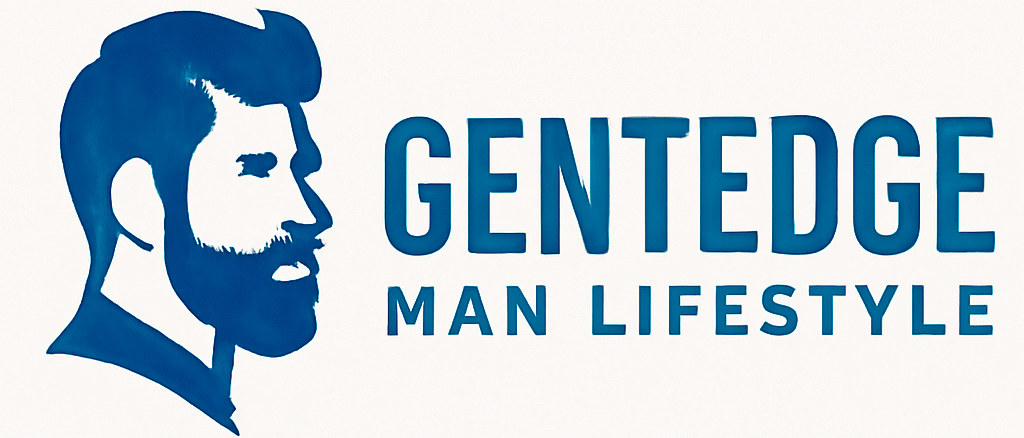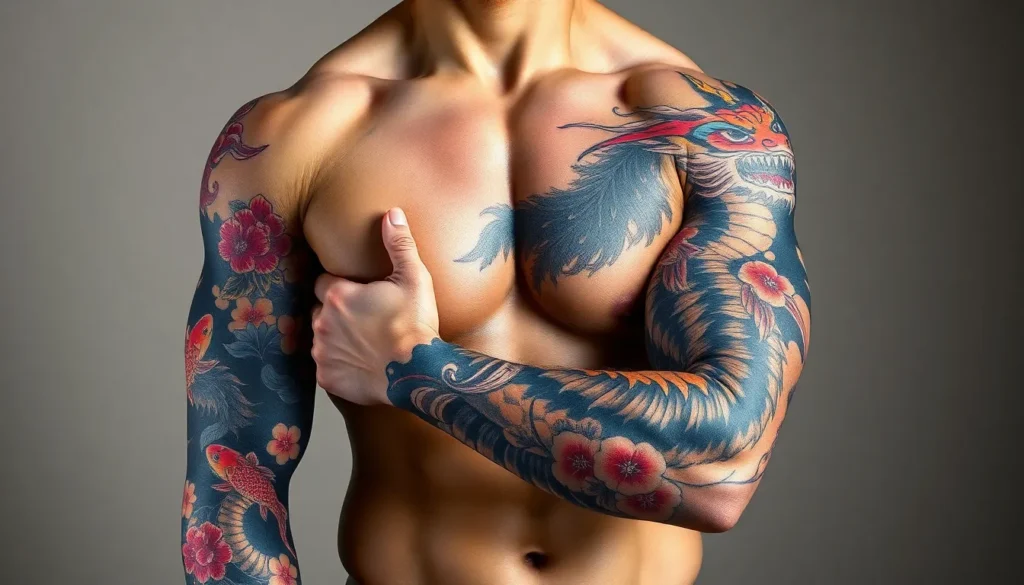Japanese tattoo sleeves for men represent one of the most captivating and meaningful forms of body art in the industry. We’ve witnessed an incredible surge in popularity as more men embrace the rich symbolism and stunning artistry that defines traditional Japanese tattooing. From fierce dragons and koi fish to cherry blossoms and samurai warriors, these intricate designs tell powerful stories that resonate deeply with modern masculinity.
What sets Japanese sleeve tattoos apart isn’t just their visual impact – it’s the centuries-old tradition and cultural significance woven into every line. We understand that choosing a Japanese sleeve design is more than selecting artwork; it’s about connecting with a heritage that values honor, strength, and spiritual transformation.
Whether you’re drawn to the bold imagery of mythical creatures or the subtle elegance of nature-inspired motifs, Japanese tattoo sleeves offer endless possibilities for personal expression. We’ll guide you through everything you need to know about these remarkable designs and help you discover why they’ve become the ultimate choice for discerning men seeking meaningful body art.
Traditional Japanese Tattoo Elements Perfect for Men’s Sleeves
Building on the rich cultural foundation we’ve established, let’s explore the exact elements that make Japanese sleeve tattoos so compelling for men.
Dragons and Their Symbolic Power
Dragons reign supreme as the most popular choice for Japanese tattoo sleeves among men. These mythical creatures represent wisdom, strength, and protection in Japanese culture, making them ideal for full arm compositions. We often see dragons portrayed with flowing bodies that wrap naturally around the arm, creating ever-changing movement from shoulder to wrist.
Eastern dragons differ significantly from their Western counterparts, featuring serpentine bodies without wings and benevolent personalities. Traditional Japanese dragons come in several varieties: Ryu (the most common), Sui Ryu (water dragons), and Ri Ryu (thunder dragons). Each type offers unique visual elements like swirling clouds, lightning bolts, or crashing waves that fill sleeve space beautifully.
Placement considerations matter when incorporating dragons into men’s sleeves. Artists typically position the dragon’s head on the upper arm or shoulder, allowing the body to spiral down toward the forearm. This creates a natural flow that follows the arm’s muscle structure and enhances the wearer’s physique.
Koi Fish Swimming Upstream
Koi fish symbolize perseverance and determination, making them perfect for men who value overcoming obstacles. These colorful fish traditionally swim upward in Japanese tattoo designs, representing the journey toward success and personal growth. We recommend koi for men who want meaningful symbolism combined with vibrant colors.
Color choices carry exact meanings in traditional koi tattoo designs. Black koi represent overcoming adversity, red koi symbolize love and bravery, while gold koi signify wealth and prosperity. Blue koi often represent tranquility and peace, giving men multiple options to express their personality through color selection.
Water elements enhance the overall composition when featuring koi in sleeve designs. Artists incorporate flowing water, lotus flowers, and rocks to create complete underwater scenes. These additional elements help fill negative space while maintaining the traditional Japanese aesthetic that makes sleeves so visually striking.
Cherry Blossoms and Seasonal Beauty
Cherry blossoms add delicate contrast to the bold elements typically found in men’s Japanese sleeves. These flowers represent the fleeting nature of life and beauty, creating philosophical depth that resonates with mature men. We find they work exceptionally well as background elements or transitional pieces between larger focal points.
Seasonal timing affects how artists incorporate cherry blossoms into sleeve designs. Spring blossoms appear full and vibrant, while fallen petals suggest autumn and change. This temporal element allows men to tell stories about different life stages through their tattoos, making each sleeve unique to the wearer’s journey.
Artistic balance becomes crucial when combining cherry blossoms with masculine elements like dragons or warriors. Skilled artists use the flowers’ soft pink and white tones to soften harsh black lines while maintaining the overall strength of the design. This creates visual harmony that appeals to men seeking both power and beauty in their tattoos.
Samurai Warriors in Battle
Samurai warriors embody the masculine ideals of honor, courage, and discipline that many men admire. These historical figures make powerful focal points for Japanese sleeves, often depicted in full armor with traditional weapons like katanas or naginatas. We see warriors positioned prominently on the upper arm where they command attention and respect.
Armor details provide intricate opportunities for artistic expression in men’s sleeve tattoos. Traditional samurai armor includes layered plates, ornate helmets, and family crests that add texture and depth to the overall design. These elements require skilled artists who understand historical accuracy and can render fine details that remain clear over time.
Battle scenes create ever-changing storytelling opportunities within sleeve compositions. Artists often depict samurai in combat poses, wielding weapons against mythical creatures or enemy forces. Wind effects, flying fabric, and scattered cherry blossoms add movement that brings these historical scenes to life on men’s arms.
Modern Japanese Sleeve Designs That Appeal to Contemporary Men
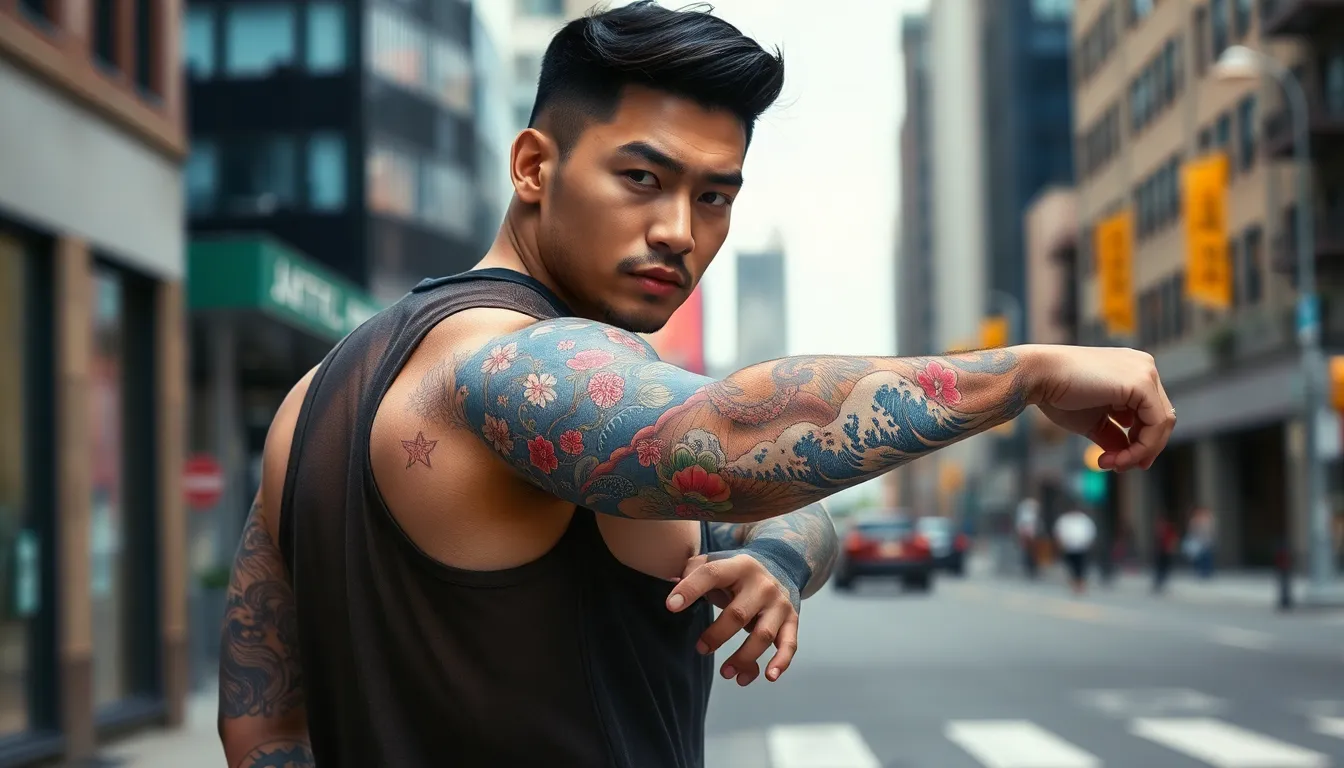
Today’s Japanese sleeve tattoos blend time-honored traditions with contemporary aesthetics, creating unique designs that resonate with modern men seeking meaningful body art.
Anime and Manga Inspired Artwork
Popular culture influences have transformed the Japanese tattoo industry through anime and manga inspired designs. Characters from beloved series now appear alongside traditional motifs, creating a fresh interpretation of Japanese sleeve art. We see artists incorporating iconic figures like samurai from Studio Ghibli films or legendary warriors from popular manga series.
Bold linework and vibrant colors characterize these contemporary pieces, often featuring ever-changing action poses that complement the arm’s natural movement. Modern tattoo artists blend these pop culture elements with traditional Japanese backgrounds like clouds, waves, or cherry blossoms to maintain cultural authenticity.
Minimalist Japanese Characters and Symbols
Simplicity defines this approach to Japanese sleeve tattoos, focusing on clean kanji characters and iconic symbols. Single kanji representing concepts like strength, honor, or wisdom can serve as powerful focal points within a larger composition. Hannya masks and oni demons rendered in minimalist styles offer dramatic impact without overwhelming detail.
We recommend discussing the meaning of chosen kanji with your artist to ensure proper cultural representation and personal significance. These understated designs appeal to men who prefer subtle elegance over elaborate imagery while still honoring Japanese tattoo traditions.
Geometric Japanese Patterns
Traditional Japanese art forms inspire geometric interpretations that add contemporary flair to sleeve designs. Kirie paper cutting patterns translate beautifully into tattoo designs, creating intricate geometric backgrounds that complement organic elements like dragons or koi fish. Kumihimo braiding patterns offer another unique geometric option that can wrap around the arm in flowing, interconnected designs.
These patterns work exceptionally well as connecting elements between major tattoo components, creating visual harmony throughout the entire sleeve composition.
Neo-Traditional Japanese Fusion Styles
Innovation meets tradition through neo-traditional Japanese fusion, where classic motifs receive modern artistic treatment. Dragons appear with enhanced dimensional shading and contemporary color palettes while maintaining their symbolic power and cultural significance. Koi fish designs incorporate bold outlines and saturated colors that make traditional symbols pop with modern vibrancy.
Cherry blossoms get reimagined with graphic design elements, creating striking contrasts between delicate natural forms and bold geometric shapes. We’ve observed artists successfully combining traditional wave patterns with contemporary stippling techniques, producing sleeves that honor the past while embracing current tattoo artistry trends.
Color Schemes That Make Japan Tattoo Sleeves Stand Out

Color selection transforms Japanese tattoo sleeves from artwork into powerful statements of personal identity. We’ll explore the most striking color schemes that elevate these traditional designs.
Bold Black and Gray Traditional Approach
Black and gray schemes dominate traditional Japanese tattoo artistry for their timeless appeal and dramatic impact. This classic color palette emphasizes bold black lines and shading, creating depth through varying tones of gray that make each element stand out distinctly.
Traditional masters relied on this monochromatic approach because it showcased technical skill through intricate shading techniques. We see how black ink creates striking contrast against skin, while gray tones add dimension to elements like dragon scales, wave patterns, and warrior armor.
Artists achieve remarkable detail using only these two colors, proving that complexity doesn’t require a rainbow palette. Black outlines define each design element clearly, while gray gradients create the illusion of movement in flowing water or billowing clouds.
Vibrant Red and Gold Combinations
Red and gold pairings bring luxury and spiritual significance to Japanese sleeve designs, highlighting key elements with royal elegance. These colors traditionally represent power, prosperity, and divine protection in Japanese culture, making them perfect for emphasizing dragons, koi fish, or cherry blossoms.
Vibrant red often fills the bodies of dragons or the petals of sakura flowers, creating focal points that draw the eye immediately. Gold accents appear in details like dragon claws, samurai armor trim, or the centers of flowers, adding depth and richness to the overall composition.
Artists use these warm tones strategically to create visual hierarchy within complex sleeve designs. Red backgrounds can make other elements pop forward, while gold highlights simulate light reflection on scales or metal surfaces.
Blue Water and Wind Elements
Blue tones evoke the natural forces of water and wind that feature prominently in Japanese tattoo mythology. These colors create ever-changing movement through wave patterns, storm clouds, and flowing garments that seem to dance across the arm.
Water elements like crashing waves or gentle streams use various blue shades from deep navy to bright cerulean. Wind representations appear through swirling cloud formations or the flowing robes of deities and warriors, all rendered in complementary blue tones.
Ocean blues paired with white foam create the famous wave motifs inspired by classical Japanese art. Sky blues blend seamlessly with gray tones to represent storm systems or peaceful heavens surrounding mythological figures.
Full Color Spectrum Traditional Irezumi
Traditional irezumi incorporates the complete color spectrum to create visually striking and detailed sleeve masterpieces. This comprehensive approach includes reds, blues, golds, and greens working together harmoniously across the entire arm surface.
Full spectrum designs require master level artistry to balance multiple colors without creating visual chaos. Green elements often represent nature aspects like bamboo leaves or serpent scales, while purple tones add mystical qualities to supernatural creatures.
Complex color layering in irezumi creates three dimensional effects that make tattoos appear to move with muscle flexion. Artists blend warm and cool tones strategically, ensuring each color serves the overall composition while maintaining traditional Japanese aesthetic principles.
Placement Options for Your Japanese Sleeve Tattoo
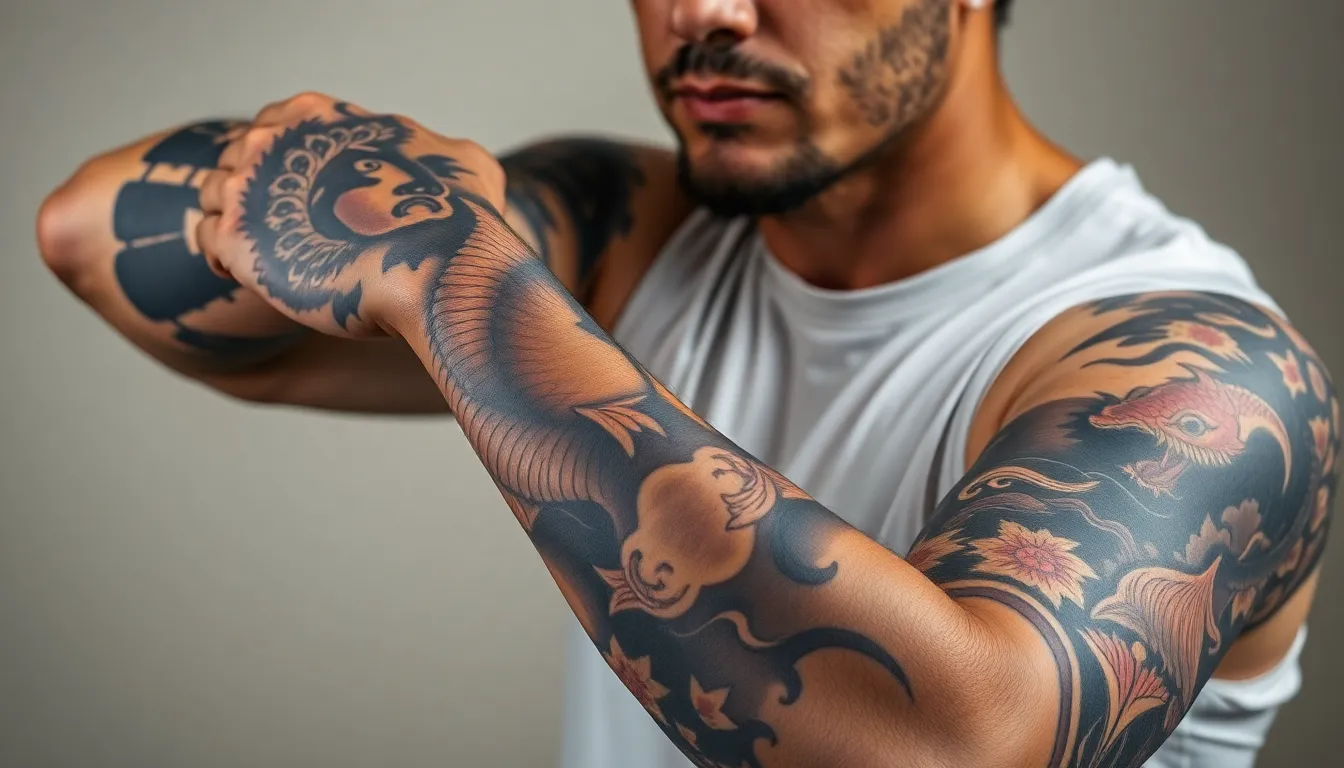
Choosing the right placement for your Japanese sleeve tattoo is crucial for achieving the perfect balance between artistic expression and lifestyle compatibility. We’ll explore four distinct placement approaches that cater to different preferences and professional requirements.
Full Arm Coverage from Shoulder to Wrist
Full arm coverage, known as Nagasode, represents the most comprehensive approach to Japanese sleeve tattoos. This traditional style starts at the chest, covers the shoulder completely, and extends down to the wrist in one continuous design. Artists typically require 30-40 hours of tattooing time to complete a full sleeve of this magnitude.
We recommend full coverage for men who want maximum visual impact and aren’t concerned about concealment. The extended canvas allows for elaborate storytelling through interconnected motifs like dragons flowing around the arm or koi fish swimming through waves. Professional athletes, artists, and entrepreneurs in creative fields often choose this placement for its bold statement.
Budget considerations for full coverage range from $3,000 to $8,000 depending on the artist’s skill level and detail complexity. Sessions typically occur over 6-12 months, allowing proper healing between appointments and gradual design development.
Half Sleeve Designs for Professional Settings
Half sleeve designs cover the upper arm from shoulder to elbow, making them ideal for corporate environments. Business shirts and dress clothes easily conceal these tattoos during professional meetings while still providing substantial space for detailed Japanese artwork.
Corporate professionals choose half sleeves because they offer excellent design flexibility without career limitations. Popular motifs include samurai masks, cherry blossoms, and compact dragon designs that wrap around the upper arm naturally. Banking executives, lawyers, and healthcare professionals frequently select this placement option.
Completion time for half sleeves averages 15-20 hours across 4-6 sessions. Costs generally range from $1,500 to $4,000, making them more accessible than full coverage while maintaining artistic integrity.
Quarter Sleeve Compact Arrangements
Quarter sleeve tattoos cover the area from mid-upper arm to elbow, providing a subtle yet impactful canvas. This placement works exceptionally well for men testing their comfort level with visible tattoos or those preferring minimalist approaches to Japanese imagery.
Compact arrangements focus on single powerful elements rather than complex narratives. Lone koi fish, individual cherry blossom branches, or simplified dragon heads create striking visuals without overwhelming the limited space. Tech workers, teachers, and government employees often prefer this conservative approach.
Artists complete quarter sleeves in 8-12 hours over 2-4 sessions. Investment typically ranges from $800 to $2,500, making them the most budget-friendly sleeve option while maintaining traditional Japanese aesthetics.
Forearm Focus Japanese Motifs
Forearm tattoos concentrate on the lower arm from elbow to wrist, creating highly visible displays of Japanese artistry. This placement showcases intricate details effectively since the forearm provides a relatively flat, prominent surface for viewing.
Visibility makes forearm placement perfect for men proud to display their Japanese tattoo heritage daily. Traditional motifs like dragons, koi fish, and cherry blossoms work exceptionally well in this vertical format. Restaurant owners, retail managers, and creative professionals commonly choose forearm focus designs.
Forearm sessions require 10-15 hours spread across 3-5 appointments. Pricing ranges from $1,000 to $3,500 depending on design complexity and color choices, offering excellent value for highly visible placement.
Cultural Significance Behind Popular Japanese Tattoo Symbols
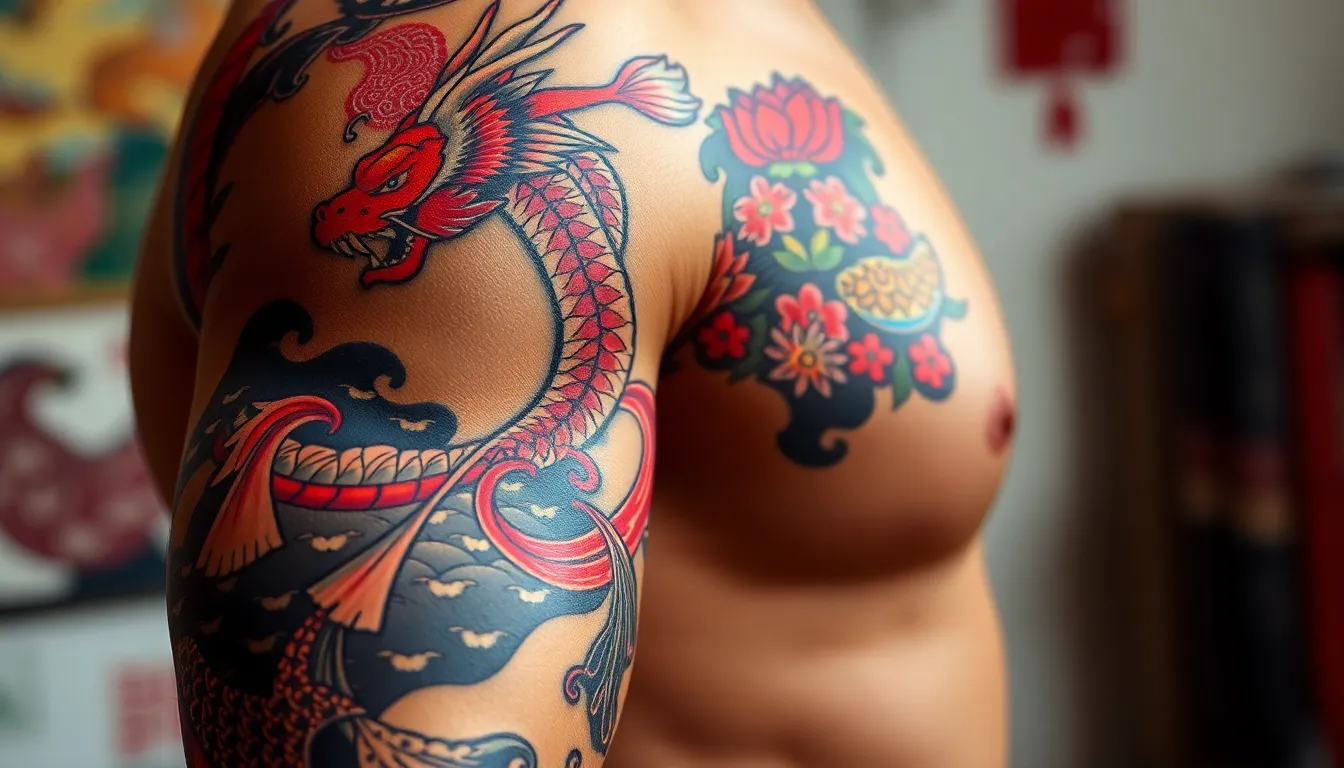
Traditional Japanese tattoo sleeves transform into powerful narratives through their symbolic elements, each carrying centuries of cultural meaning and mythology. We’ve compiled the most important symbols that define authentic Japanese sleeve designs for men.
Understanding the Meaning of Dragons
Dragons dominate Japanese tattoo artistry as the ultimate symbols of wisdom, strength, and protection. These mythological creatures differ dramatically from their Western counterparts, embodying benevolent forces that control natural elements and guard precious treasures. Artists typically depict dragons in ever-changing, flowing poses that enhance the arm’s natural contours while showcasing their power.
Japanese folklore presents dragons as wise protectors rather than destructive beasts. They’re revered as guardians of sacred spaces and symbols of imperial authority. Men choosing dragon motifs often connect with these qualities of leadership and protective strength.
The intricate scales, flowing whiskers, and powerful claws require exceptional artistic skill to execute properly. Dragons frequently serve as the central focal point around which other elements revolve. Their serpentine bodies create natural movement that follows the arm’s musculature perfectly.
Koi Fish Transformation Stories
Koi fish embody perseverance, transformation, and the pursuit of greatness through their legendary upstream journey. The most famous tale tells of koi swimming against powerful currents to reach the Dragon Gate, where they transform into mighty dragons upon success. This metamorphosis represents overcoming life’s greatest challenges and achieving personal transformation.
Color choices carry exact meanings within koi designs. Black koi symbolize overcoming adversity, while golden koi represent prosperity and good fortune. Red koi embody love and bravery, making them popular choices for men seeking to express courage.
Artists often depict koi swimming through turbulent waters, cherry blossoms, or alongside lotus flowers. The fish’s natural swimming motion creates ever-changing flow within sleeve compositions. Their scales provide opportunities for intricate detail work that showcases technical mastery.
Phoenix Rising from Ashes
Phoenix designs capture the eternal cycle of death, rebirth, and renewal through stunning visual storytelling. This mythical bird’s ability to rise from its own ashes creates powerful metaphors for resilience and new beginnings. Men often choose phoenix motifs during important life transitions or after overcoming personal struggles.
Japanese phoenix imagery differs from Western interpretations, featuring more elaborate plumage and graceful proportions. Artists incorporate flames, clouds, and wind elements to emphasize the phoenix’s connection to transformation. The bird’s outstretched wings create dramatic compositions across the arm’s surface.
Phoenix tattoos require careful planning to showcase the bird’s majestic nature effectively. Their feathers provide opportunities for color gradation and intricate linework. Many designs incorporate the phoenix emerging from stylized flames that wrap around the arm naturally.
Tiger Strength and Courage Symbolism
Tigers represent raw strength, courage, and determination while serving as powerful protectors against evil spirits. Japanese culture reveres tigers for their fearless nature and unwavering resolve in facing danger. These big cats symbolize the warrior spirit that many men aspire to embody.
Traditional tiger designs emphasize the animal’s muscular power through bold linework and dramatic poses. Artists often depict tigers mid-pounce or roaring, creating intense focal points within sleeve compositions. The contrast between the tiger’s orange coat and black stripes provides natural opportunities for striking color work.
Tigers frequently appear alongside bamboo forests, wind bars, or rocky landscapes that enhance their wild nature. Their powerful presence commands attention while maintaining balance with surrounding elements. The tiger’s piercing gaze and bared fangs create emotional intensity that resonates with masculine energy.
Choosing the Right Tattoo Artist for Japanese Sleeve Work
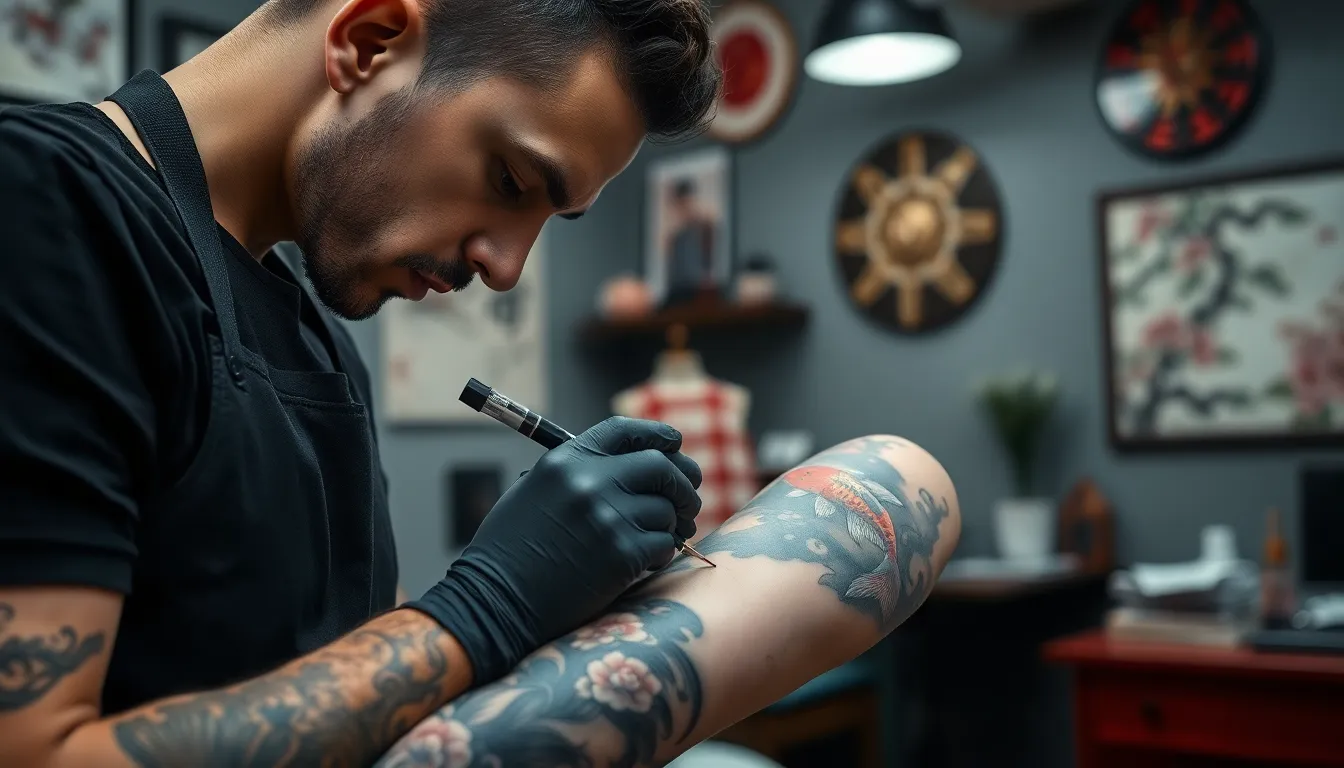
Selecting the perfect artist becomes crucial when you’re ready to transform your vision into a masterpiece. We can’t emphasize enough how this decision impacts both the artistic quality and cultural authenticity of your Japanese sleeve tattoo.
Finding Artists Specializing in Japanese Style
Research artists who specifically advertise expertise in Irezumi, Wabori, or Harimono techniques. We recommend looking for studios that prominently feature Japanese tattoo work in their portfolios and marketing materials. Many reputable artists have undergone formal training or apprenticeships under experienced masters who’ve dedicated their careers to this ancient art form.
Check social media platforms and tattoo convention appearances where specialized artists often showcase their latest Japanese sleeve work. We’ve found that artists who truly specialize in this style regularly post progress shots of dragons, koi, cherry blossoms, and mythological figures. Professional tattoo directories and online forums also provide valuable insights from previous clients who’ve received Japanese sleeve work.
Visit multiple studios to assess their commitment to Japanese tattooing. We suggest asking about the artist’s background, training, and years of experience specifically with Japanese designs. Studios that take this art form seriously often display traditional Japanese art references, maintain relationships with Japanese tattoo culture, and demonstrate ongoing education in the style’s historical significance.
Evaluating Portfolio Quality and Authenticity
Examine portfolios for traditional elements including bold outlines, vivid colors, and ever-changing compositions inspired by ukiyo-e woodblock prints. We look for authentic Japanese sleeves that display proper balance, movement, and depth with culturally meaningful motifs. Artists who understand the style create pieces that flow naturally with the arm’s anatomy while respecting traditional iconography.
Assess consistency and clarity in shading techniques across multiple pieces in their portfolio. We recommend paying attention to how well the artist handles complex backgrounds, water elements, and the intricate details that make Japanese tattoos distinctive. Quality portfolios showcase various stages of sleeve development, from initial outlines to fully healed final results.
Verify cultural accuracy in their interpretation of traditional symbols. We’ve noticed that authentic artists understand the proper placement of elements like wind bars, water, and traditional background patterns. Their work demonstrates respect for the cultural significance behind each design choice rather than simply copying aesthetic elements without understanding their meaning.
Understanding Traditional Techniques vs Modern Methods
Traditional Japanese tattooing employs the tebori method, involving hand poking techniques with bamboo or steel needles. We find this ancient approach creates unique textures and colors that differ significantly from machine work. Artists trained in tebori often produce softer gradations and more organic looking skin integration, though the process requires significantly more time and sessions.
Modern artists frequently use electric machines for efficiency and precision while still respecting traditional practices and design principles. We’ve observed that many contemporary Japanese tattoo specialists blend both approaches, using machines for outlines and base colors while incorporating hand techniques for exact textural effects. This hybrid method can reduce session time while maintaining authentic visual results.
Discuss technique preferences during your consultation to understand how your chosen method affects both appearance and experience. We recommend asking about healing times, pain levels, and long term appearance differences between traditional and modern approaches. Your artist should explain their exact process and why they’ve chosen their particular combination of techniques.
Consultation Process and Design Development
Initial consultations involve comprehensive discussions about design concepts, placement strategies, and the artist’s creative process. We encourage clients to bring reference images while remaining open to the artist’s expertise in adapting traditional motifs for modern sleeve compositions. Professional artists collaborate with clients to customize designs that blend traditional elements with personal meaning and individual anatomy.
Expect to review multiple sketches and discuss detailed color schemes before beginning the tattooing process. We’ve found that reputable artists spend considerable time refining designs, ensuring proper flow and cultural authenticity throughout the sleeve. This development phase often includes discussions about session scheduling, as Japanese sleeves typically require multiple appointments spanning several months.
Clear communication ensures realistic expectations and culturally authentic results. We recommend discussing timeline expectations, total costs, and aftercare requirements during the consultation phase. Professional artists provide detailed explanations of their design choices, helping clients understand how traditional Japanese elements work together to create visually impactful and culturally respectful sleeve tattoos.
Pain Levels and Healing Process for Japanese Sleeve Tattoos
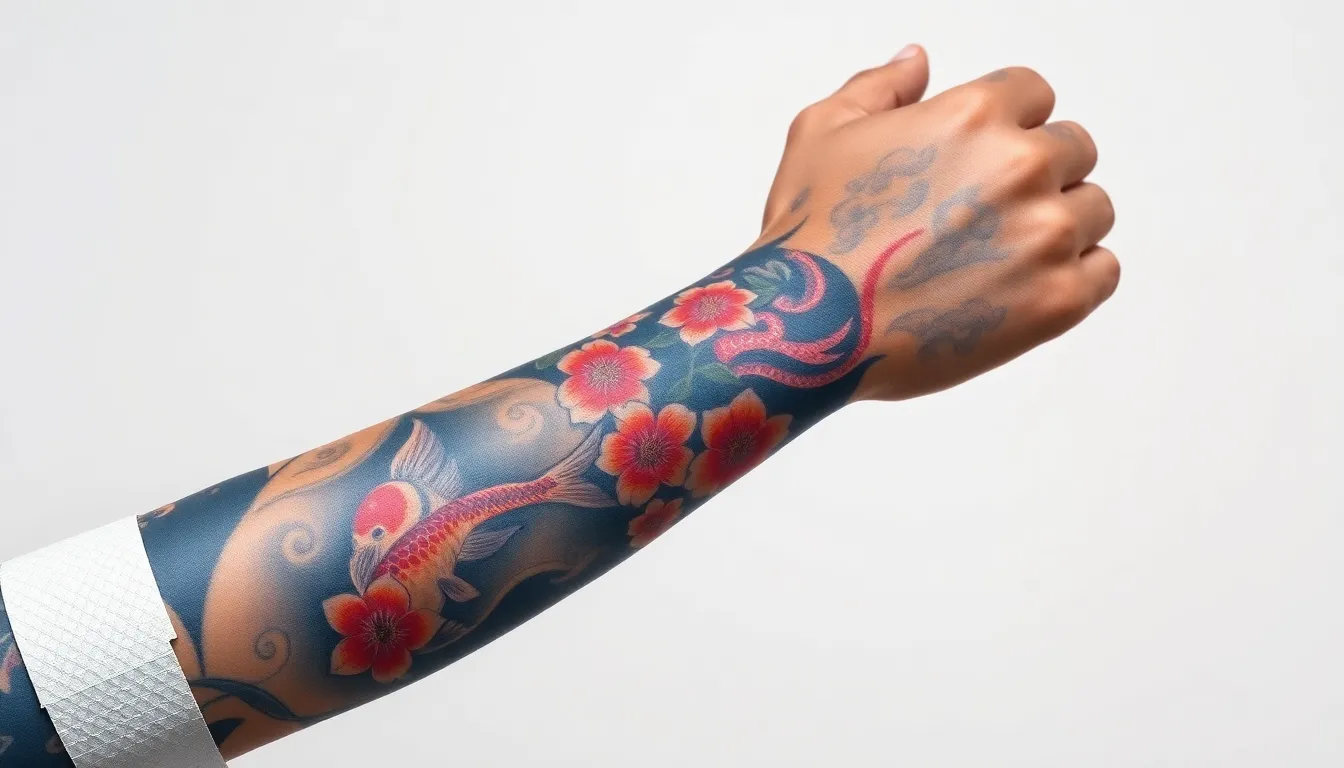
Understanding the physical demands of a Japanese sleeve tattoo helps you prepare for the commitment ahead. We’ll explore the realities of pain management and healing expectations across multiple sessions.
Most Painful Areas During Sleeve Sessions
Armpit regions rank among the most challenging areas during sleeve sessions, creating intense discomfort due to sensitive nerve clusters. Outer elbow zones follow closely, where thin skin meets bone structure underneath, amplifying the tattooing sensation significantly.
Inner elbow areas present unique challenges with their delicate skin and proximity to major blood vessels. Wrist sections complete the list of high sensitivity zones, where minimal tissue separates the needle from bone contact.
Bony protrusions throughout the arm create sharp, stinging sensations that differ from the dull ache in fleshier areas. Solid tissue zones beneath thin skin produce the most uncomfortable experiences, requiring mental preparation and pain management strategies.
Managing Multiple Tattoo Appointments
Scheduling intervals of two weeks between sessions allows your skin to heal completely before continuing the artwork. Session planning typically requires 8 to 10 appointments for a full Japanese sleeve, depending on design complexity and detail density.
Healing assessment between appointments determines your readiness for the next session, as individual recovery rates vary significantly. Appointment spacing should prioritize skin health over speed, ensuring optimal results throughout the entire process.
Recovery monitoring helps you understand your personal healing timeline and adjust future appointments accordingly. Session preparation includes proper rest, hydration, and avoiding alcohol before each appointment to minimize discomfort and promote healing.
Proper Aftercare for Large Japanese Designs
Bandage maintenance for 4 to 6 hours after each session protects the fresh tattoo from environmental contaminants. Overnight coverage may be recommended for extensive work areas to prevent bedding contact during initial healing.
Cleaning protocols involve gentle washing with antibacterial soap to remove excess ink and plasma buildup. Moisturizing routines with tattoo exact products prevent scabbing and maintain skin elasticity during the healing process.
Activity restrictions during healing periods protect your investment and prevent damage to intricate Japanese design elements. Follow up care with your artist ensures any healing concerns are addressed promptly and professionally.
Timeline Expectations for Complete Sleeves
Project duration spans several months to over a year for completing a full Japanese sleeve tattoo. Design complexity directly impacts the timeline, with intricate traditional elements requiring more detailed work sessions.
Personal healing rates influence the overall timeframe, as some individuals recover faster between sessions than others. Artist availability and your scheduling flexibility affect how quickly you can progress through the multiple appointment sequence.
Seasonal considerations may impact healing, with summer months potentially requiring longer intervals between sessions due to sun exposure concerns. Completion milestones help track progress and maintain motivation throughout the extended tattooing journey.
Cost Considerations for Japan Tattoo Sleeves for Men
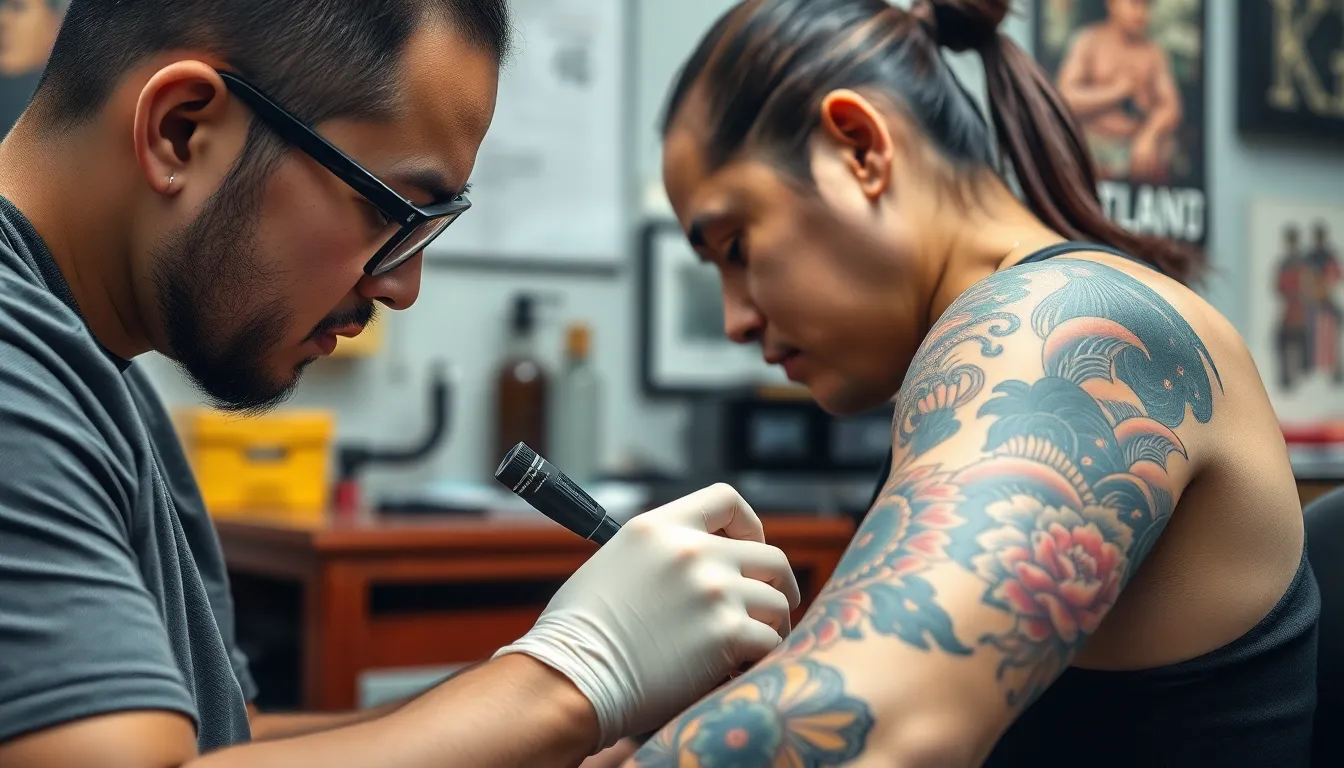
Understanding the financial investment required for a Japanese sleeve tattoo helps you plan effectively for this important artistic commitment.
Factors Affecting Overall Pricing
Design complexity stands as the primary driver of costs, with intricate traditional Japanese motifs requiring exceptional skill and time. A full sleeve demands 20 to 30 hours of work, typically spread across 5 to 8 sessions, making time investment a major pricing factor. Artist reputation significantly impacts rates, as established practitioners with proven expertise in Japanese traditional work command premium prices. Location plays a crucial role in determining costs, with tattoo studios in major cities charging substantially more than those in smaller towns. Skin condition affects the number of sessions required, with some clients needing additional appointments to achieve optimal results.
Budgeting for Multiple Sessions
Session planning requires careful financial preparation since Japanese sleeves can’t be completed in single appointments. Each session typically lasts several hours, with studios often offering discounted rates for extended appointments to reduce overall costs. Hourly rates average around $400 per session, though pricing models vary between artists and studios. Healing time between sessions means you’ll spread payments over several months, making budgeting more manageable than paying the full amount upfront. Some artists offer package deals for complete sleeve projects, potentially saving you money compared to individual session rates.
Quality vs Cost Balance
Experienced artists specializing in Japanese tattooing typically charge $380 to $550 per hour, reflecting their specialized skills and cultural knowledge. Higher costs often correlate with superior artistry, ensuring your sleeve maintains authentic Japanese aesthetics and technical excellence. Studio overhead including premium inks, sterile equipment, and professional facilities contributes to pricing but guarantees safety and quality outcomes. Investing in skilled practitioners prevents costly cover up work or disappointment with subpar results that cheaper alternatives might produce.
Maintenance and Touch Up Expenses
Initial aftercare products represent additional upfront costs but protect your investment during the critical healing phase. Touch up sessions may become necessary over time as tattoos naturally fade or settle, adding to long term expenses. Proper maintenance including sun protection and moisturizing helps preserve your sleeve’s vibrancy and reduces future touch up needs. Total investment for a complete Japanese sleeve typically exceeds $5,000, with traditional irezumi artists in Japan charging 10,000 to 15,000 yen per hour for authentic work.
Conclusion
Japanese tattoo sleeves represent more than just body art—they’re a profound commitment to artistry tradition and personal expression. We’ve explored how these intricate designs blend centuries-old symbolism with modern aesthetics creating meaningful narratives on your skin.
The journey to your perfect Japanese sleeve requires careful consideration of design elements artist selection and financial planning. From understanding the cultural significance of dragons and koi fish to handling the physical demands of multiple sessions every aspect deserves thoughtful attention.
Remember that this investment extends beyond the initial tattooing process. Proper aftercare maintenance and occasional touch-ups ensure your sleeve remains vibrant for years to come. With the right preparation and commitment your Japanese tattoo sleeve will become a lasting testament to both artistic excellence and personal significance.
Frequently Asked Questions
What makes Japanese tattoo sleeves so popular among men?
Japanese tattoo sleeves combine captivating visual designs with deep cultural symbolism. They feature powerful imagery like dragons, koi fish, cherry blossoms, and samurai warriors that represent values such as strength, honor, perseverance, and wisdom. These tattoos offer more than just aesthetic appeal—they provide a meaningful connection to Japanese culture and philosophy, making them attractive to men seeking significant body art.
What are the most common symbols used in Japanese sleeve tattoos?
The most popular symbols include dragons (representing wisdom and protection), koi fish (symbolizing perseverance and transformation), cherry blossoms (representing life’s fleeting nature), samurai warriors (embodying honor and courage), phoenix (signifying resilience and renewal), and tigers (representing strength and courage). Each symbol carries deep cultural meanings and contributes to the overall narrative of the sleeve design.
How do modern Japanese tattoo sleeves differ from traditional ones?
Modern interpretations blend traditional elements with contemporary aesthetics. They incorporate influences from anime and manga, feature minimalist kanji characters, include geometric patterns inspired by traditional Japanese art, and utilize neo-traditional fusion styles. These modern approaches maintain cultural significance while embracing current tattoo artistry trends and appealing to contemporary preferences.
What color schemes work best for Japanese tattoo sleeves?
Popular color schemes include bold black and gray for traditional depth, vibrant red and gold combinations for luxury and spiritual significance, blue tones for representing water and wind elements, and full color spectrum (irezumi) for maximum visual impact. The choice depends on personal preference, design complexity, and the specific symbolism you want to emphasize in your sleeve.
What placement options are available for Japanese sleeve tattoos?
There are four main placement options: full arm coverage (Nagasode) for maximum impact, half sleeve designs balancing artistry with professional requirements, quarter sleeve tattoos for subtle yet impactful displays, and forearm focus designs for highly visible Japanese artistry. Each option varies in time commitment, cost, and suitability for different lifestyles and professional settings.
How do I choose the right tattoo artist for a Japanese sleeve?
Look for artists specializing in traditional Japanese techniques like Irezumi, Wabori, or Harimono. Evaluate their portfolios for authenticity and quality, understand the differences between traditional tebori methods and modern machine techniques, and ensure they have experience with Japanese cultural elements. Schedule consultations to assess their knowledge and communication skills regarding culturally respectful designs.
How painful is getting a Japanese sleeve tattoo?
Pain levels vary by location, with the armpit, outer elbow, inner elbow, and wrist being the most sensitive areas. Japanese sleeves typically require 8 to 10 sessions with healing time between appointments. Pain management strategies include proper rest, staying hydrated, and following your artist’s recommendations. The process spans several months to over a year depending on design complexity.
What does a Japanese sleeve tattoo cost?
A full Japanese sleeve typically requires 20 to 30 hours of work across multiple sessions. Experienced artists specializing in Japanese tattooing charge between $380 to $550 per hour, with sessions averaging around $400 each. Total costs can range from several thousand to over ten thousand dollars, depending on design complexity, artist reputation, and location. Budget for potential touch-ups and maintenance as well.
How long does it take to complete a Japanese sleeve tattoo?
Completion time varies from several months to over a year, influenced by design complexity, personal healing rates, and seasonal considerations. Most sleeves require 8 to 10 sessions with 2-4 weeks healing time between appointments. The process involves careful planning, multiple consultations, and patience to ensure proper healing and optimal artistic results throughout the lengthy tattooing journey.
What aftercare is required for Japanese sleeve tattoos?
Proper aftercare includes maintaining bandages as directed, following specific cleaning protocols with antibacterial soap, applying recommended moisturizers, avoiding sun exposure and swimming, and restricting certain activities during healing. Each session requires 2-4 weeks of careful aftercare. Following your artist’s instructions precisely is crucial for preserving the tattoo’s vibrancy, preventing infection, and ensuring optimal healing results.
